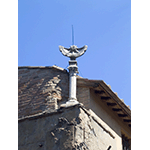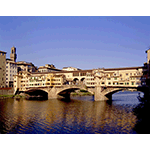Ponte Vecchio
Already in Roman times, at the point where the Arno narrows, a bridge was built over which the Via Cassia could cross the river, so as to connect Rome to Cisalpine Gaul. Up to the 13th century Ponte Vecchio, first built of wood, was the city's only bridge. After the flood of 1333, it was rebuilt in 1345, with a three-arched structure and shops standing along both sides, in buildings interrupted at the centre by a little plaza. Here, on the roof of a shop, is an ancient sundial, supported by a small white marble pillar. The sundial's orientation to the south is marked by a little sculpture portraying a lizard. Under the sundial is a stone table, now almost illegible, which recalls: "In the year thirty-three after One Thousand Three Hundred, the bridge collapsed due to floods of water; twelve years later, as pleased the Commune, it was rebuilt with this ornamentation". The sundial is formed of a white marble cup divided by slender columns indicating the canonical hours. The gnomon projects its shadow onto the cup, thus marking the hour of the day. In 1565, with the construction of the Vasari Corridor that connects Palazzo Vecchio to the Pitti royal palace, Ponte Vecchio acquired a new position of centrality in the urban grid.
****************************
Texts by Graziano Magrini
English translation by Catherine Frost
Last update 12/gen/2008





